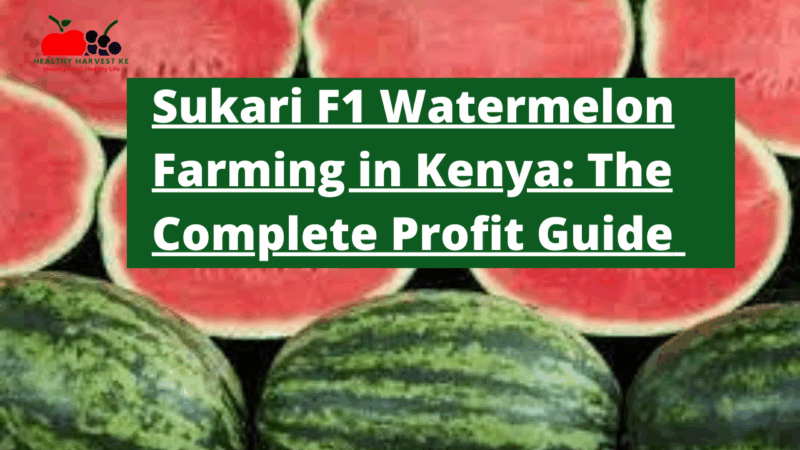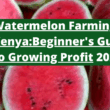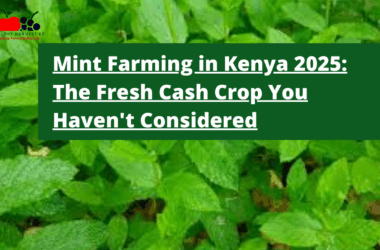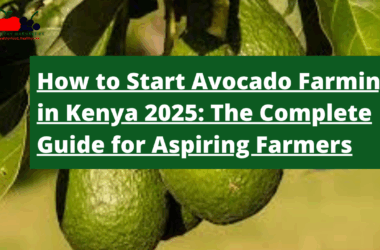Growing watermelons in Kenya’s warm climate isn’t just refreshing – it’s a seriously lucrative business opportunity that more savvy farmers are tapping into. If you’re looking for a crop with quick returns and strong market demand, Sukari F1 watermelon deserves your attention.
Let me break down why this particular watermelon variety is becoming the go-to choice for Kenyan farmers who want to maximize their profits without waiting forever for returns. From getting started to best practices that’ll boost your bottom line, consider this your cheat code to watermelon farming success.
Why Sukari F1 Watermelon Is Kenya’s Most Profitable Melon
When it comes to commercial watermelon farming in Kenya, not all varieties deliver equal returns. Sukari F1 has emerged as the clear frontrunner, and for good reason.
This hybrid variety combines early maturity with exceptional fruit characteristics that both local and export markets can’t get enough of. The numbers speak for themselves – with proper management, you’re looking at impressive yields of 25-35 tons per acre.
What makes Sukari F1 stand out is its perfect blend of practical advantages:
- Quick harvest cycle: 75-90 days from planting to harvest means faster returns on your investment
- Transportability: The thick rind provides excellent protection during transport, reducing losses when supplying distant markets
- Market appeal: That distinctive light green rind with dark green stripes catches consumers’ eyes, while the deep crimson flesh delivers the sweetness (11-12% TSS) that keeps them coming back
Each fruit typically weighs between 7-8 kg, though they can reach up to 15 kg under optimal conditions. This size range hits the sweet spot for both retail and wholesale markets.

Starting Your Sukari F1 Watermelon Farm: First Steps to Success
Ready to dive into Sukari F1 watermelon farming? Here’s how to lay the groundwork for a profitable operation.
Selecting the Perfect Location
Sukari F1 thrives in Kenya’s arid and semi-arid regions – places like Machakos and Makueni counties offer ideal growing conditions. You’re looking for areas with:
- Warm temperatures (25-35°C during the day)
- Lower altitude
- Good access to water for irrigation
- Well-draining soils
These conditions minimize disease pressure while promoting sugar development in the fruits – key to achieving that signature sweetness that commands premium prices.
Free PDF DownloadLand Preparation and Planting
Before you get those seeds in the ground, proper land preparation is non-negotiable:
- Thoroughly plow and harrow to create a fine seedbed
- Set up your planting layout at 100 × 80 cm spacing (optimizing for about 5,000 plants per acre)
- Prepare your planting holes
- Use approximately 500 grams of Sukari F1 seeds per acre
While seed costs represent a significant investment (ranging from Ksh 12,400-12,900 for 500g), the potential returns make it worthwhile. Quality seeds from reputable suppliers are one area where cutting corners will cost you more in the long run.
Timing Your Planting
Strategic timing can significantly impact your profitability. In Kenya, watermelons are typically planted during two main seasons:
- March to May (long rains)
- October to December (short rains)
Planting during these periods helps reduce irrigation costs, though supplemental irrigation will still be necessary, especially in drier regions.
Irrigation: The Make-or-Break Factor for Profitability
If there’s one aspect of Sukari F1 farming that separates the profitable operations from the struggling ones, it’s irrigation management.
Why Drip Is King
Drip irrigation has proven to be the gold standard for Sukari F1 production in Kenya. Though installation costs more upfront, the ROI is undeniable:
- Delivers water directly to the root zone
- Reduces water usage by up to 40% compared to overhead methods
- Keeps foliage dry, preventing powdery mildew and other moisture-related diseases
- Allows for precision fertilizer application through fertigation
For optimal results, your Sukari F1 plants need approximately 65 liters of water per week per plant. With drip irrigation, this translates to about 30 minutes of daily watering, ensuring moisture penetrates to around 6 inches depth.
Smart Irrigation Scheduling
Your irrigation schedule should flex with the plant’s growth stages:
- Seedling stage: Light, frequent irrigation
- Vegetative growth: Moderate, consistent moisture
- Flowering and fruit development: Increased frequency to support fruit expansion
- Ripening: Reduced irrigation to concentrate sugars and improve flavor
Pro tip: Irrigate early in the morning or late evening to minimize evaporative losses – crucial for profitability in hot regions.

Fertilization Strategy for Maximum Yields
Your nutrient management plan directly impacts both yield quantity and quality. Here’s the blueprint for feeding your Sukari F1 watermelons for maximum profit:
Basal Fertilization: Setting the Foundation
Start with soil testing to understand what you’re working with. For basal application:
- Apply Diammonium Phosphate (DAP) at 50 kg per acre
- Place approximately one teaspoonful in each planting hole
- Mix thoroughly with soil to prevent seed burning
- For enhanced efficiency, consider mixing HUMIPOWER with basal fertilizers (1 kg HUMIPOWER to 50 kg fertilizer)
This foundation supports strong root development – crucial for the plant’s ability to access water and nutrients throughout its lifecycle.
Top-Dressing and Foliar Applications
About 3-4 weeks after sowing, when plants enter active vegetative growth:
- Top-dress with Calcium Ammonium Nitrate (CAN) at 50-100 kg per acre
- Apply as one teaspoonful per plant in a ring approximately 15 cm from the stem
- Support vegetative growth with foliar applications like GOLDCHANCE SUPER GROWTH (50g/20L) or LAVENDER SUPER GROWTH & VEGETATIVE (20ml/20L)
Flowering and Fruiting Nutrition
During these critical stages, targeted nutritional support pays dividends:
- Apply foliar products rich in potassium and micronutrients
- Options include GOLDCHANCE SUPER FLOWERS & FRUITS (50g/20L), DIMIPHITE (20ml/20L), or LAVENDER SUPER FLOWERS & FRUITS (20ml/20L)
- These enhance pollination, fruit set, and development – directly impacting your harvest quality
Consider the organic biostimulant OPTIMIZER throughout any growth stage to help plants manage environmental stresses and maintain productive growth.
Pest and Disease Management: Protecting Your Investment
All your hard work can be undermined by pests and diseases if you’re not vigilant. Here’s how to keep your Sukari F1 crop protected:
Melon Fly: The Major Threat
The melon fly (Bactrocera cucurbitae) is perhaps the most destructive pest for Sukari F1 watermelons in Kenya. These flies lay eggs in developing fruits, where hatched larvae tunnel through the flesh, causing rotting and premature dropping.
Effective management includes:
- Field monitoring using pheromone traps (cue lure baited traps or Bactrolure L) combined with Malathion
- Wrapping young fruits with protective eco-bags
- Promptly removing and properly disposing of infested fruits
- Strategic applications of insecticides containing Deltamethrin (Decis 2.5 EC) or Trichlofon (Dipterex 95 SP) when necessary
Disease Prevention
Powdery mildew is a significant threat, appearing as white powdery growth on leaf surfaces. Your defense strategy:
- Use drip irrigation to keep foliage dry
- Apply fungicides containing sulfur or triazole compounds at early disease stages
- Practice crop rotation (avoiding cucurbit crops in the same field for 2-3 years)
- Maintain proper field sanitation
Regular scouting allows for early detection and intervention before diseases can significantly impact your yields and profits.

Harvesting and Post-Harvest Handling for Maximum Returns
Timing your harvest correctly and handling the fruits properly afterward are crucial for maximizing profits.
Harvest Indicators
Look for these signs that your Sukari F1 watermelons are ready for harvest:
- The tendril nearest to the fruit stem dries up and turns brown
- The fruit surface becomes dull rather than shiny
- The bottom of the fruit (where it touches the ground) turns from white to cream or yellow
- A hollow sound when tapped (experienced farmers can identify this)
Post-Harvest Handling
Proper handling directly impacts marketability and price:
- Harvest during cooler hours (early morning or late evening)
- Cut stems with sharp, clean tools, leaving 2-3 cm of stem attached
- Handle fruits carefully to avoid bruising
- Sort by size and quality
- Store in cool, shaded areas if not immediately transporting to market
Market Opportunities: Where to Sell Your Sukari F1 Watermelons
Understanding your market options is key to maximizing profits from your Sukari F1 watermelon farm.
Domestic Markets
Sukari F1 watermelons enjoy strong demand in Kenya’s domestic markets, particularly in urban centers like Nairobi and Mombasa where consumer purchasing power is higher. The variety’s excellent transportability makes it suitable for distribution across the country even from remote production areas.
Direct selling options include:
- Local markets
- Supermarkets
- Hotels and restaurants
- Roadside stalls in high-traffic areas
Export Markets
Beyond local markets, export opportunities exist for quality Sukari F1 watermelons:
- Regional markets in Uganda, Rwanda, and South Sudan show increasing demand
- Middle Eastern countries like Kuwait ($65.4k exports in 2022), UAE ($7.34k), and Qatar ($7.25k)
- Other emerging markets include Maldives ($9.95k) and Somalia ($5.87k)
These export markets typically demand consistent quality, proper packaging, and reliable supply – but they also pay premium prices.
Value Addition: Beyond Fresh Fruit Sales
To maximize profitability, consider these value-addition opportunities for your Sukari F1 watermelons:
Juice Production
Sukari F1’s deep red, sweet flesh produces appealing juice with minimal processing. With basic equipment like pulpers and pasteurization units, you can create bottled watermelon juice with extended shelf life. Marketing it as a premium health product, highlighting its lycopene content and hydrating properties, can command higher prices.
Alternative Products
Other value-added options include:
- Pickled watermelon rinds (Sukari F1’s thick rind is ideal for this)
- Roasted watermelon seeds as nutritious snacks
- Watermelon fruit leather, preserves, and fermented products
These alternatives help stabilize income throughout the year rather than just during harvest seasons.
Cost-Benefit Analysis: The Bottom Line
Let’s break down the numbers to understand the profit potential of Sukari F1 watermelon farming in Kenya:
| Item | Cost/Revenue per Acre |
|---|---|
| Land preparation | Ksh 8,000-12,000 |
| Seeds (500g) | Ksh 12,400-12,900 |
| Fertilizers | Ksh 15,000-20,000 |
| Irrigation setup (drip) | Ksh 10,000-15,000 |
| Pesticides and fungicides | Ksh 5,000-8,000 |
| Labor | Ksh 10,000-12,000 |
| Total Investment | Ksh 60,400-79,900 |
| Yield | 25-35 tons per acre |
| Farm gate price | Ksh 15-25 per kg |
| Gross Revenue | Ksh 375,000-875,000 |
| Estimated Profit | Ksh 295,100-795,100 |
With proper management, you’re looking at a potential ROI of 370-995% within just 3-4 months – making Sukari F1 watermelon one of Kenya’s most profitable short-term crops.
Final Thoughts: Your Path to Watermelon Farming Success
Sukari F1 watermelon farming in Kenya offers a compelling opportunity for those looking to maximize returns on agricultural investments. The variety’s superior characteristics combined with Kenya’s favorable growing conditions create an ideal match for profitable farming.
Success hinges on implementing the proper agronomic practices we’ve covered – particularly irrigation management, fertilization, and pest control strategies tailored to local conditions.
For new entrants, start with thorough market research, secure quality seed from reputable suppliers, and implement the recommended production practices we’ve discussed. As Kenya’s watermelon export sector continues to develop, farmers who can consistently produce high-quality Sukari F1 watermelons will be well-positioned to capture growing market opportunities both locally and internationally.
Ready to dive in? Your profitable watermelon farming journey starts now.
Have you tried growing Sukari F1 watermelons or have questions about getting started? Drop a comment below – I’d love to hear from you.










